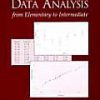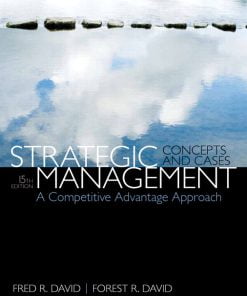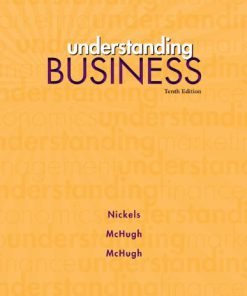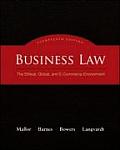Solution Manual for Design of Reinforced Concrete 10th by McCormac
$35.00 Original price was: $35.00.$26.50Current price is: $26.50.
Solution Manual for Design of Reinforced Concrete 10th by McCormac
This is completed downloadable of Solution Manual for Design of Reinforced Concrete 10th by McCormac
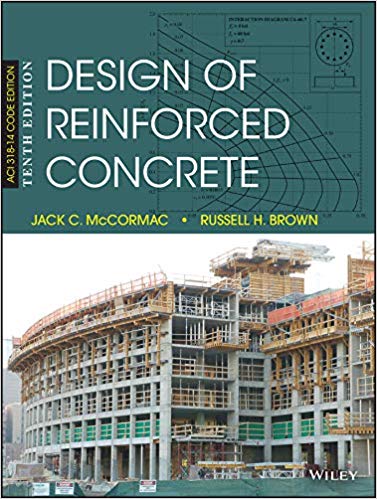
Product Details:
ISBN 13: 978-1118879108
Author: Jack C. McCormac (Author), Russell H. Brown (Author)
Design of Reinforced Concrete, 10th Edition by Jack McCormac and Russell Brown, introduces the fundamentals of reinforced concrete design in a clear and comprehensive manner and grounded in the basic principles of mechanics of solids. Students build on their understanding of basic mechanics to learn new concepts such as compressive stress and strain in concrete, while applying current ACI Code.
Table of Content:
Introduction 1
1.1 Concrete and Reinforced Concrete, 1
1.2 Advantages of Reinforced Concrete as a Structural Material, 1
1.3 Disadvantages of Reinforced Concrete as a Structural Material, 2
1.4 Historical Background, 3
1.5 Comparison of Reinforced Concrete and Structural Steel for Buildings and Bridges, 5
1.6 Compatibility of Concrete and Steel, 6
1.7 Design Codes, 6
1.8 Summary of 2014 ACI Code Changes, 7
1.9 SI Units and Shaded Areas, 7
1.10 Types of Portland Cement, 8
1.11 Admixtures, 9
1.12 Properties of Concrete, 10
1.13 Aggregates, 17
1.14 High-Strength Concretes, 18
1.15 Fiber-Reinforced Concretes, 20
1.16 Concrete Durability, 21
1.17 Reinforcing Steel, 21
1.18 Grades of Reinforcing Steel, 23
1.19 SI Bar Sizes and Material Strengths, 24
1.20 Corrosive Environments, 26
1.21 Identifying Marks on Reinforcing Bars, 26
1.22 Introduction to Loads, 26
1.23 Dead Loads, 27
1.24 Live Loads, 28
1.25 Environmental Loads, 30
1.26 Selection of Design Loads, 31
1.27 Calculation Accuracy, 32
1.28 Impact of Computers on Reinforced Concrete Design, 33
Problems, 33
2 Flexural Analysis of Beams 34
2.1 Introduction, 34
2.2 Cracking Moment, 37
2.3 Elastic Stresses—Concrete Cracked, 40
2.4 Ultimate or Nominal Flexural Moments, 47
2.5 SI Example, 50
2.6 Computer Examples, 51
Problems, 53
3 Strength Analysis of Beams According to ACI Code 64
3.1 Design Methods, 64
3.2 Advantages of Strength Design, 65
3.3 Structural Safety, 65
3.4 Derivation of Beam Expressions, 66
3.5 Strains in Flexural Members, 69
3.6 Balanced Sections, Tension-Controlled Sections, and Compression-Controlled or Brittle Sections, 70
3.7 Strength Reduction or ? Factors, 70
3.8 Minimum Percentage of Steel, 72
3.9 Balanced Steel Percentage, 74
3.10 Example Problems, 75
3.11 Computer Examples, 79
Problems, 79
4 Design of Rectangular Beams and One-Way Slabs 81
4.1 Load Factors, 81
4.2 Design of Rectangular Beams, 83
4.3 Beam Design Examples, 88
4.4 Miscellaneous Beam Considerations, 94
4.5 Determining Steel Area When Beam Dimensions Are Predetermined, 95
4.6 Bundled Bars, 97
4.7 One-Way Slabs, 98
4.8 Cantilever Beams and Continuous Beams, 101
4.9 SI Example, 102
4.10 Computer Example, 104
Problems, 105
5 Analysis and Design of T Beams and Doubly Reinforced Beams 110
5.1 T Beams, 110
5.2 Analysis of T Beams, 112
5.3 Another Method for Analyzing T Beams, 116
5.4 Design of T Beams, 117
5.5 Design of T Beams for Negative Moments, 123
5.6 L-Shaped Beams, 125
5.7 Compression Steel, 125
5.8 Design of Doubly Reinforced Beams, 130
5.9 SI Examples, 134
5.10 Computer Examples, 136
Problems, 141
6 Serviceability 152
6.1 Introduction, 152
6.2 Importance of Deflections, 152
6.3 Control of Deflections, 153
6.4 Calculation of Deflections, 154
6.5 Effective Moments of Inertia, 154
6.6 Long-Term Deflections, 157
6.7 Simple-Beam Deflections, 159
6.8 Continuous-Beam Deflections, 161
6.9 Types of Cracks, 167
6.10 Control of Flexural Cracks, 168
6.11 ACI Code Provisions Concerning Cracks, 171
6.12 SI Example, 172
6.13 Miscellaneous Cracks, 173
6.14 Computer Example, 173
Problems, 175
7 Bond, Development Lengths, and Splices 180
7.1 Cutting Off or Bending Bars, 180
7.2 Bond Stresses, 183
7.3 Development Lengths for Tension Reinforcement, 185
7.4 Development Lengths for Bundled Bars, 193
7.5 Hooks, 194
7.6 Development Lengths for Welded Wire Fabric in Tension, 200
7.7 Development Lengths for Compression Bars, 201
7.8 Critical Sections for Development Length, 203
7.9 Effect of Combined Shear and Moment on Development Lengths, 203
7.10 Effect of Shape of Moment Diagram on Development Lengths, 204
7.11 Cutting Off or Bending Bars (Continued), 205
7.12 Bar Splices in Flexural Members, 208
7.13 Tension Splices, 209
7.14 Compression Splices, 210
7.15 Headed and Mechanically Anchored Bars, 211
7.16 SI Example, 212
7.17 Computer Example, 213
Problems, 214
8 Shear and Diagonal Tension 220
8.1 Introduction, 220
8.2 Shear Stresses in Concrete Beams, 220
8.3 Lightweight Concrete, 221
8.4 Shear Strength of Concrete, 221
8.5 Shear Cracking of Reinforced Concrete Beams, 223
8.6 Web Reinforcement, 224
8.7 Behavior of Beams with Web Reinforcement, 225
8.8 Design for Shear, 227
8.9 ACI Code Requirements, 229
8.10 Shear Design Example Problems, 233
8.11 Economical Spacing of Stirrups, 243
8.12 Shear Friction and Corbels, 245
8.13 Shear Strength of Members Subjected to Axial Forces, 247
8.14 Shear Design Provisions for Deep Beams, 249
8.15 Introductory Comments on Torsion, 250
8.16 SI Example, 252
8.17 Computer Example, 253
Problems, 254
9 Introduction to Columns 259
9.1 General, 259
9.2 Types of Columns, 260
9.3 Axial Load Capacity of Columns, 262
9.4 Failure of Tied and Spiral Columns, 262
9.5 Code Requirements for Cast-in-Place Columns, 265
9.6 Safety Provisions for Columns, 267
9.7 Design Formulas, 268
9.8 Comments on Economical Column Design, 269
9.9 Design of Axially Loaded Columns, 270
9.10 SI Example, 273
9.11 Computer Example, 274
Problems, 275
10 Design of Short Columns Subject to Axial Load and Bending 277
10.1 Axial Load and Bending, 277
10.2 The Plastic Centroid, 278
10.3 Development of Interaction Diagrams, 280
10.4 Use of Interaction Diagrams, 286
10.5 Code Modifications of Column Interaction Diagrams, 288
10.6 Design and Analysis of Eccentrically Loaded Columns Using Interaction Diagrams, 289
10.7 Shear in Columns, 297
10.8 Biaxial Bending, 298
10.9 Design of Biaxially Loaded Columns, 302
10.10 Continued Discussion of Capacity Reduction Factors, ?, 305
10.11 Computer Example, 306
Problems, 308
11 Slender Columns 313
11.1 Introduction, 313
11.2 Nonsway and Sway Frames, 313
11.3 Slenderness Effects, 314
11.4 Determining k Factors with Alignment Charts, 316
11.5 Determining k Factors with Equations, 318
11.6 First-Order Analyses Using Special Member Properties, 319
11.7 Slender Columns in Nonsway and Sway Frames, 320
11.8 ACI Code Treatments of Slenderness Effects, 323
11.9 Magnification of Column Moments in Nonsway Frames, 323
11.10 Magnification of Column Moments in Sway Frames, 328
11.11 Analysis of Sway Frames, 331
11.12 Computer Examples, 337
Problems, 340
12 Footings 343
12.1 Introduction, 343
12.2 Types of Footings, 343
12.3 Actual Soil Pressures, 345
12.4 Allowable Soil Pressures, 346
12.5 Design of Wall Footings, 348
12.6 Design of Square Isolated Footings, 353
12.7 Footings Supporting Round or Regular Polygon-Shaped Columns, 359
12.8 Load Transfer from Columns to Footings, 359
12.9 Rectangular Isolated Footings, 364
12.10 Combined Footings, 367
12.11 Footing Design for Equal Settlements, 373
12.12 Footings Subjected to Axial Loads and Moments, 375
12.13 Transfer of Horizontal Forces, 377
12.14 Plain Concrete Footings, 378
12.15 SI Example, 381
12.16 Computer Examples, 383
Problems, 386
13 Retaining Walls 389
13.1 Introduction, 389
13.2 Types of Retaining Walls, 389
13.3 Drainage, 392
13.4 Failures of Retaining Walls, 393
13.5 Lateral Pressure on Retaining Walls, 393
13.6 Footing Soil Pressures, 398
13.7 Design of Semigravity Retaining Walls, 399
13.8 Effect of Surcharge, 402
13.9 Estimating the Sizes of Cantilever Retaining Walls, 403
13.10 Design Procedure for Cantilever Retaining Walls, 407
13.11 Cracks and Wall Joints, 418
Problems, 420
14 Continuous Reinforced Concrete Structures 425
14.1 Introduction, 425
14.2 General Discussion of Analysis Methods, 425
14.3 Qualitative Influence Lines, 425
14.4 Limit Design, 428
14.5 Limit Design under the ACI Code, 435
14.6 Preliminary Design of Members, 438
14.7 Approximate Analysis of Continuous Frames for Vertical Loads, 438
14.8 Approximate Analysis of Continuous Frames for Lateral Loads, 448
14.9 Computer Analysis of Building Frames, 451
14.10 Lateral Bracing for Buildings, 452
14.11 Development Length Requirements for Continuous Members, 452
Problems, 458
15 Torsion 463
15.1 Introduction, 463
15.2 Torsional Reinforcing, 464
15.3 Torsional Moments That Have to Be Considered in Design, 467
15.4 Torsional Stresses, 468
15.5 When Torsional Reinforcement Is Required by the ACI, 469
15.6 Torsional Moment Strength, 470
15.7 Design of Torsional Reinforcing, 471
15.8 Additional ACI Requirements, 472
15.9 Example Problems Using U.S. Customary Units, 473
15.10 SI Equations and Example Problem, 476
15.11 Computer Example, 480
Problems, 481
16 Two-Way Slabs, Direct Design Method 485
16.1 Introduction, 485
16.2 Analysis of Two-Way Slabs, 488
16.3 Design of Two-Way Slabs by the ACI Code, 488
16.4 Column and Middle Strips, 489
16.5 Shear Resistance of Slabs, 490
16.6 Depth Limitations and Stiffness Requirements, 492
16.7 Limitations of Direct Design Method, 498
16.8 Distribution of Moments in Slabs, 498
16.9 Design of an Interior Flat Plate, 504
16.10 Placing of Live Loads, 508
16.11 Analysis of Two-Way Slabs with Beams, 509
16.12 Transfer of Moments and Shears between Slabs and Columns, 515
16.13 Openings in Slab Systems, 520
16.14 Computer Example, 521
Problems, 523
17 Two-Way Slabs, Equivalent Frame Method 524
17.1 Moment Distribution for Nonprismatic Members, 524
17.2 Introduction to the Equivalent Frame Method, 525
17.3 Properties of Slab Beams, 527
17.4 Properties of Columns, 530
17.5 Example Problem, 532
17.6 Computer Analysis, 536
17.7 Computer Example, 537
Problems, 538
18 Walls 539
18.1 Introduction, 539
18.2 Non-Load-Bearing Walls, 539
18.3 Load-Bearing Concrete Walls—Empirical Design Method, 540
18.4 Load-Bearing Concrete Walls—Rational Design, 543
18.5 Shear Walls, 545
18.6 ACI Provisions for Shear Walls, 549
18.7 Economy in Wall Construction, 555
18.8 Computer Example, 555
Problems, 557
19 Prestressed Concrete 559
19.1 Introduction, 559
19.2 Advantages and Disadvantages of Prestressed Concrete, 561
19.3 Pretensioning and Posttensioning, 561
19.4 Materials Used for Prestressed Concrete, 562
19.5 Stress Calculations, 564
19.6 Shapes of Prestressed Sections, 568
19.7 Prestress Losses, 570
19.8 Ultimate Strength of Prestressed Sections, 573
19.9 Deflections, 576
19.10 Shear in Prestressed Sections, 580
19.11 Design of Shear Reinforcement, 582
19.12 Additional Topics, 586
19.13 Computer Example, 588
Problems, 589
20 Reinforced Concrete Masonry (Online only at www.wiley.com/college/mccormac) 1
20.1 Introduction, 1
20.2 Masonry Materials, 1
20.3 Specified Compressive Strength of Masonry, 5
20.4 Maximum Flexural Tensile Reinforcement, 6
20.5 Walls with Out-of-Plane Loads—Non-Load-Bearing Walls, 6
20.6 Masonry Lintels, 10
20.7 Walls with Out-of-Plane Loads—Load-Bearing Walls, 15
20.8 Walls with In-Plane Loading—Shear Walls, 22
20.9 Computer Example, 27
Problems, 29
A Tables and Graphs: U.S. Customary Units 593
B Tables in SI Units 631
C The Strut-and-Tie Method of Design (Online only at www.wiley.com/college/mccormac) 1
C.1 Introduction, 1
C.2 Deep Beams, 1
C.3 Shear Span and Behavior Regions, 1
C.4 Truss Analogy, 3
C.5 Definitions, 4
C.6 ACI Code Requirements for Strut-and-Tie Design, 4
C.7 Selecting a Truss Model, 6
C.8 Angles of Struts in Truss Models, 8
C.9 Design Procedure, 8
D Seismic Design of Reinforced Concrete Structures (Online only at www.wiley.com/college/mccormac) 1
D.1 Introduction, 1
D.2 Maximum Considered Earthquake, 2
D.3 Soil Site Class, 2
D.4 Risk and Importance Factors, 4
D.5 Seismic Design Categories, 5
D.6 Seismic Design Loads, 5
D.7 Detailing Requirements for Different Classes of Reinforced Concrete Moment Frames, 9
Problems, 16
Glossary 637
Index 641
People Also Search:
design of reinforced concrete
design of reinforced concrete 10th by mccormac
design of reinforced concrete solution manual download pdf
design of reinforced concrete download scribd
Related products
Solution Manual
Solution Manual
Solution Manual
International Accounting Doupnik 4th Edition Solutions Manual
Solution Manual
Understanding Business Nickels 10th Edition Solutions Manual
Solution Manual
Solution Manual
Solution Manual for Data Structures and Other Objects Using C++, 4/E Michael Main, Walter Savitch



